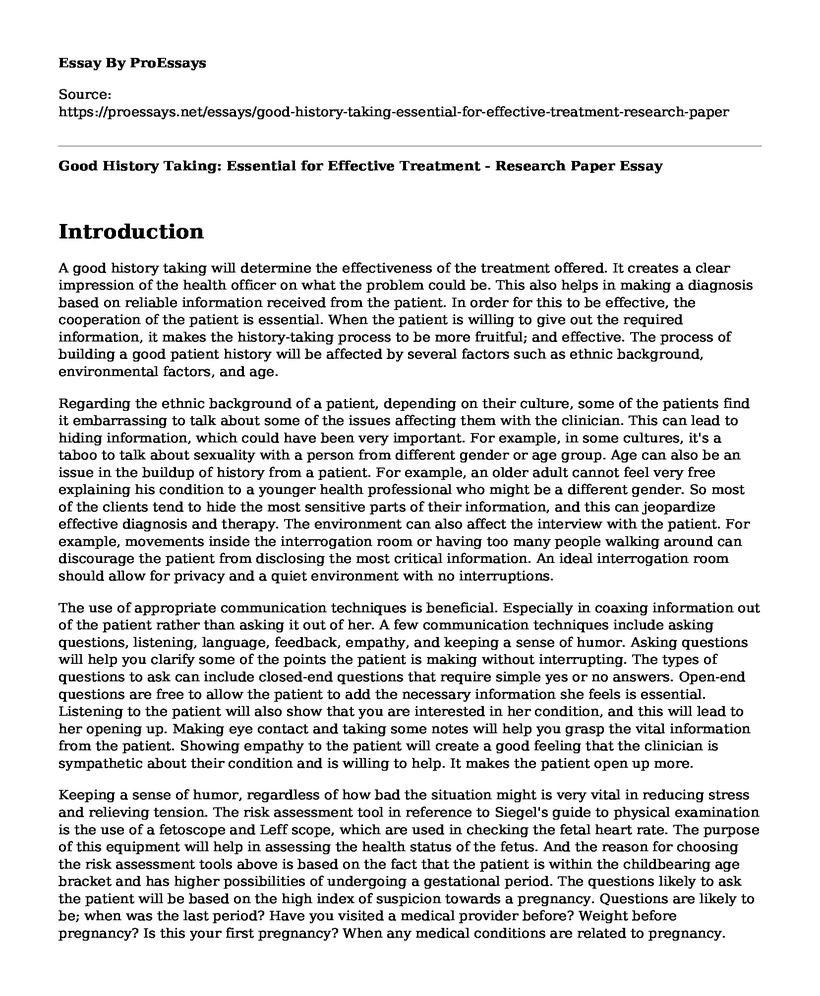Introduction
A good history taking will determine the effectiveness of the treatment offered. It creates a clear impression of the health officer on what the problem could be. This also helps in making a diagnosis based on reliable information received from the patient. In order for this to be effective, the cooperation of the patient is essential. When the patient is willing to give out the required information, it makes the history-taking process to be more fruitful; and effective. The process of building a good patient history will be affected by several factors such as ethnic background, environmental factors, and age.
Regarding the ethnic background of a patient, depending on their culture, some of the patients find it embarrassing to talk about some of the issues affecting them with the clinician. This can lead to hiding information, which could have been very important. For example, in some cultures, it's a taboo to talk about sexuality with a person from different gender or age group. Age can also be an issue in the buildup of history from a patient. For example, an older adult cannot feel very free explaining his condition to a younger health professional who might be a different gender. So most of the clients tend to hide the most sensitive parts of their information, and this can jeopardize effective diagnosis and therapy. The environment can also affect the interview with the patient. For example, movements inside the interrogation room or having too many people walking around can discourage the patient from disclosing the most critical information. An ideal interrogation room should allow for privacy and a quiet environment with no interruptions.
The use of appropriate communication techniques is beneficial. Especially in coaxing information out of the patient rather than asking it out of her. A few communication techniques include asking questions, listening, language, feedback, empathy, and keeping a sense of humor. Asking questions will help you clarify some of the points the patient is making without interrupting. The types of questions to ask can include closed-end questions that require simple yes or no answers. Open-end questions are free to allow the patient to add the necessary information she feels is essential. Listening to the patient will also show that you are interested in her condition, and this will lead to her opening up. Making eye contact and taking some notes will help you grasp the vital information from the patient. Showing empathy to the patient will create a good feeling that the clinician is sympathetic about their condition and is willing to help. It makes the patient open up more.
Keeping a sense of humor, regardless of how bad the situation might is very vital in reducing stress and relieving tension. The risk assessment tool in reference to Siegel's guide to physical examination is the use of a fetoscope and Leff scope, which are used in checking the fetal heart rate. The purpose of this equipment will help in assessing the health status of the fetus. And the reason for choosing the risk assessment tools above is based on the fact that the patient is within the childbearing age bracket and has higher possibilities of undergoing a gestational period. The questions likely to ask the patient will be based on the high index of suspicion towards a pregnancy. Questions are likely to be; when was the last period? Have you visited a medical provider before? Weight before pregnancy? Is this your first pregnancy? When any medical conditions are related to pregnancy.
Conclusion
In conclusion, a good history taking session ends with both the doctor and the patient satisfied with the amount of data collected, which forms the basis of sound therapy. Nonetheless, a none cooperative patient will end up getting the wrong diagnosis and treatment. It is also important to note that the history-taking process should be flexible; it differs from one patient to the other.
References
Ball, J. W., Dains, J. E., Flynn, J. A., Solomon, B. S., & Stewart, R. W. (2019). Seidel's guide to physical examination: An interprofessional approach (9th ed.). St. Louis, MO: Elsevier Mosby.
Madigan, D., Quinlan-Ruof, E., Cambron, J., Forst, L., Zanoni, J., & Friedman, L. S. (2018). 1489 Occupational health history taking attitudes and behaviors of chiropractic interns.
Wan, X., & Zeng, R. (2020). History Taking in Special Situations. In Handbook of Clinical Diagnostics (pp. 115-116). Springer, Singapore.
Cite this page
Good History Taking: Essential for Effective Treatment - Research Paper. (2023, Mar 09). Retrieved from https://proessays.net/essays/good-history-taking-essential-for-effective-treatment-research-paper
If you are the original author of this essay and no longer wish to have it published on the ProEssays website, please click below to request its removal:
- States Board of Pharmacy Paper Example
- Acute Joint Inflammation Paper Example
- Energy Drink Drinkers are at a High Risk to get Diabetes - Essay Sample
- Hypothyroidism: A Disease Triggered by Low Iodine Levels - Essay Sample
- Essay on Sleep Habits: A Necessity for Improved Health & Performance
- Morality & Abortion: An Ethical Dilemma - Essay Sample
- Transitions in the Informed Consents - Report Example







